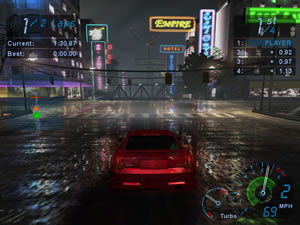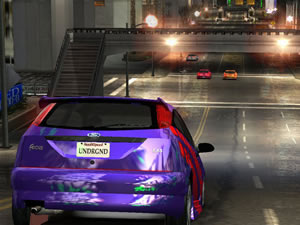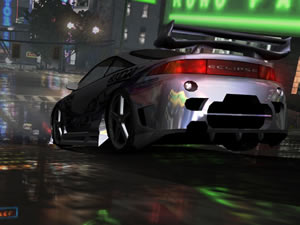Shift into the down low.
The Need For Speed series is known for its exotic cars, extreme
speed, and often-breathtaking international locations. EA has always been ready
and willing to tamper with the details of this potent elixir, varying upgrades,
limiting vehicles, intensifying traffic, altering physics, and increasing or decreasing
police presence from game to game. The latest incarnation of the series, Need
for Speed: Underground, marks a complete revamp of the main ingredients
and the result is a solid and unique arcade racer.
Single,
Two-Player and even online racing modes (on the PC and PS2, at least) are available,
but the main feature of NFS: Underground is the “Underground’
mode itself. You don’t have to delve deeper than your first race to see what’s
different about this game.
Underground is basically an illegal street racer career mode consisting of
a whopping 111 race events, including Circuit races, point-to-point Sprints,
Knock-Out, Drag races, and Drift competitions. You begin the game with a small
choice of upgradeable tuner cars like the Volkswagen Golf GTI, Dodge Neon, and
Peugeot 206 GTI. Though your chosen vehicle begins as basically a dud, you are
offered a bevy of upgrades to customize and personalize your ride making it
as unique as possible.
Unfortunately, most of the upgrades are cosmetic ” different headlamps, neons
for the underside, a different type of hood, vinyl patterns, decals, etc. There
are performance upgrades available, but these are offered in an assortment of
packages and are not a mix and match affair. While they do add speed and alter
handling, don’t expect the level of customization displayed in Need
For Speed Motor City or Gran Turismo.
Another unfortunate aspect of the customizations is that they are unlockable
as well as available for purchase. You can’t add a particular feature to your
car just because you can afford it – you’ll have to unlock it first, and you
will be unlocking far more vinyl patterns than anything else. This puts a sad
and confining limitation on customization; if you’ve earned the cash to purchase
an upgrade, you should be able to just buy it. No one down at Kragen’s is going
to talk you out of a new exhaust pipe for you car if you have the cash to pay
for it.
Thankfully, as a consolation prize, you can switch vehicles at almost any point in the game and most of your upgrades will carry over. You won’t have to start again from scratch.
NFS: Underground is an arcade-style racer, complete with
huge red arrows set up in front of buildings indicating the direction you should
be heading and a reset feature which kicks in immediately if you happen to miss
a turn and plunge beyond the designated track. The learning curve has less of
a bend than an iron rail, so this is definitely ready for any newbie to jump
on and play to their heart’s content.
 In
In
turn, the vehicles handle like arcade cars and, while they certainly are not
weightless, in collision they do twist, flip and spin much more than they would
in real life, even possessing a tendency to bounce back on the track. This makes
it possible to crash and still finish the race in first place, which provides
a nice chaos factor without tons of frustration. There is no damage modeling
on the cars, which can be a bit disconcerting after an insane collision, but
cars do not take operational damage, so you’ll never have to worry about the
engine exploding and you’ll never have to coax your wounded vehicle to limp
across a finish line.
Drag racing and Drift competitions are what really set this game apart from
its predecessors. Drag races pit the player against not one, but three other
vehicles, your own shifting ability, oncoming civilian traffic and varying road
hazards and jumps. Unlike Test Drive, it takes
more than just shifting gears at the right moments; you will also have to change
lanes to avoid whatever is thrown in front of you and opponent vehicles are
about as friendly about letting you merge as commuters stuck in bumper-to-bumper
holiday traffic at 5:30 p.m. on a Friday. This manages to be frustrating and
fun in equal parts and is a great addition to the game.
The Drift challenges pit you and your ride against a short track with a myriad of turns and grades you on how well you can ride a curve without slowing down to a crawl or banking into a wall. This, like Drag racing, takes more than a little skill and a whole lot of patience and is definitely one of the high points of the game.
Sprint and Circuit races are a weak spot for NFS: Underground.
Unlike other NFS games which had players going up against as
many as seven other vehicles, here there are a piddling three opponents and,
aside from sheer opportunism, there is nothing remarkable about them. They are
not particularly aggressive or considerably better drivers; they’re just as
likely to plow into unwary cross traffic as you are ” and that can be a good
thing. There just aren’t enough of them.
 All
All
four version of NFS: Underground feature superb graphics. The
cars are crisp and detailed and the lighting effects are first rate, with an
abundance of sparks, motion blur, light trails and lens flares. The Xbox is
obviously the smoothest of the consoles with the Gamecube and PS2 placing second
and third, respectively, but none will disappoint.
Although there’s plenty of shine and polish to this game, the glitter of these
effects are wasted on the most boring tracks on record. These are all night
tracks, all in the same “metropolitan” location, and all of them are shorter
than Emmanuel Lewis in a pair of flats. Dispensing with often stunning, international
and fantasy tracks, NFS: Underground has opted to present the
tracks as various streets in one small city. This quickly becomes as redundant
as driving around the block about 150 times and is a pure travesty when compared
to the tracks in Need for Speed:
Hot Pursuit 2 or any of the previous NFS games.
For that matter, NFS: Underground has dispensed with exotics
and faraway locales to focus on the illegal street racing scene (i.e., “The
Fast and the Furious” or just about any other Vin Diesel movie set on planet
Earth). And what would illegal street racing be without cops on your tailpipe?
Well, it would probably be very much like this game, since there’s nary a pig
to be seen. All of the coppers in Underground have apparently
converged on the local Krispy Kreme for a cruller convention so you’ll never
have an impromptu meeting with Officer Friendly no matter how much road you
manage to tear up. And that’s just a shame.
The PS2 and PC versions of NFS: Underground also have online
capability. Players can race up to three other online opponents using their
saved car from their single-player game or a default bucket. Of course, you’re
not racing for pinks since you can’t own more than one car at a time, but you
can race for online ranking recognition. And although there is no voice-support,
PS2 and PC players can battle it out against one another, a nice touch which
definitely broadens the field.
NFS: Underground is an uneven mixture of gorgeous graphics,
upgradeable street racing vehicles, variety of race modes, unique customization,
lack of opposition, repetitive tracks, and no law enforcement presence. Somehow
they have even managed to get rid of the replays all together. The additions
and subtractions seem so random, it’s almost as if they picked this game’s elements
out of a hat. But the game still manages to be involving and fun, although not
quite as engrossing as NFS:HP2. It’s surely worthy of gracing
any racing aficionado’s collection; the various events and practically endless
cosmetic customizations should keep this one out of the trade-in stack for some
time to come.








